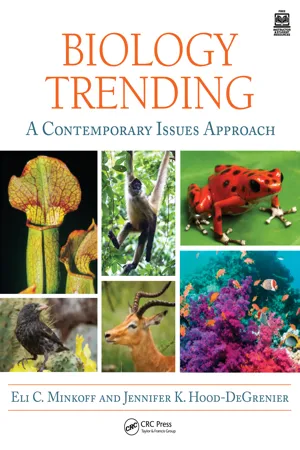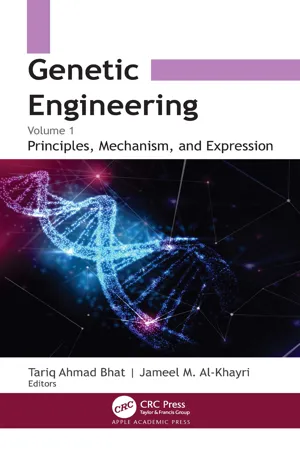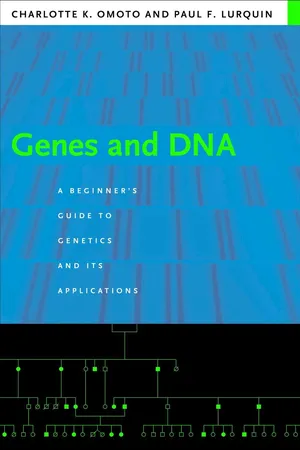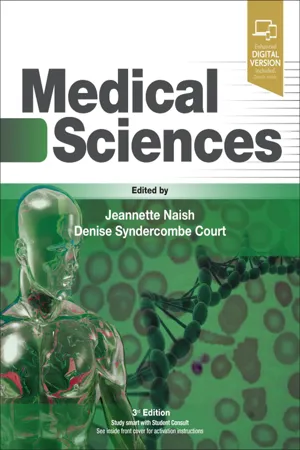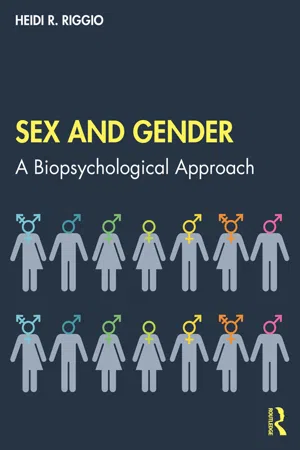Biological Sciences
Linked Genes
Linked genes are genes that are located close together on the same chromosome. They tend to be inherited together because they are physically linked and do not assort independently during meiosis. This linkage can be broken by crossing over, which can result in the exchange of genetic material between the linked genes.
Written by Perlego with AI-assistance
Related key terms
Related key terms
1 of 4
Related key terms
1 of 3
5 Key excerpts on "Linked Genes"
- eBook - ePub
Biology Trending
A Contemporary Issues Approach
- Eli Minkoff, Jennifer K. Hood-DeGrenier(Authors)
- 2023(Publication Date)
- CRC Press(Publisher)
The same rules that work for pea plants work for other species, including humans. The units that assort and segregate in inheritance have come to be known as genes. Genes are located on chromosomes, a hypothesis that was first suggested because the numbers, locations, and movements of chromosomes could explain the observed patterns of inheritance. Genes were later found to be composed of DNA, a molecule that consists of long chains of nucleotides. The double-stranded structure of DNA accounts for its ability to be replicated accurately. In the next chapter, we will examine the process of gene expression, which is how the information encoded in the sequence of DNA is accessed to make the functional molecules that determine an organism's phenotypes. We will specifically focus on the genetics of human diseases, some of which exhibit the simple patterns of inheritance discovered by Mendel, while others are more complex, involving many different genes and also being influenced by environmental factors. CHAPTER SUMMARY The study of the inheritance of biological traits is called genetics. Hereditary information is carried in the form of DNA segments known as genes, which are parts of chromosomes. An allele is a variant of a gene. Dominant alleles show up in the phenotype when either homozygous or heterozygous. Recessive alleles are only expressed when they are homozygous - eBook - ePub
Genetic Engineering
Volume 1: Principles Mechanism, and Expression
- Tariq Ahmad Bhat, Jameel M. Al-Khayri, Tariq Ahmad Bhat, Jameel M. Al-Khayri(Authors)
- 2023(Publication Date)
- Apple Academic Press(Publisher)
Gene mapping is a method of determining the particular locus or loci responsible for producing a specific biological trait. Early gene maps used the linkage analysis. In a chromosome, more the two genes are close to each other, more is the chances of their inheritance together. Two distinct maps, one physical map and the other genetic map have been used to study linkage phenomenon. Physical maps measure the number of base pairs or physical distance between base pairs by using markers while as, genetic map tells us about the nature of different regions of chromosome (Alizadeh et al., 1995 ; Griffiths, 2000). 7.4.1.3 Concept of Allelism Allele is referred to as different variants of a gene at a particular locus. Various genetists have defined the criteria of differentiating between allelic mutants. These comprise of degree of mutability, either spontaneous or induced, pattern of mutability, capability to grow on minimal medium or potential to grow at variable temperatures, complementation relations and response to the suppressor mutations. Mutation at the same site may also leads to different alleles that are phenotypically different. The sites of alleles that are responsible for related phenotypes are distributed along a gene locus (Demerec, 1961). Chromosomes have the same alleles at a specific locus in diploid and polyploidy cells, and these are referred to as homozygous, while those with different alleles are referred to as heterozygous. 7.4.1.4 Boundaries of the Locus Certain genes are grouped together that have related functions and are organized in the same order as a chain of biosynthetic reactions they control. This type of arrangement allows us to find out the degree of certainty, when two loci are in close proximity to one another and to study the areas close to their boundary line - eBook - ePub
Genes and DNA
A Beginner's Guide to Genetics and Its Applications
- Charlotte Omoto, Paul Lurquin(Authors)
- 2004(Publication Date)
- Columbia University Press(Publisher)
CHAPTER 9. Linkage and Mapping Gene Discovery AS WAS DISCUSSED IN CHAPTERS 5 AND 6 and will later be talked about in chapter 13, bacteria, plants, and animals have been genetically modified. This means that donor genes first had to be identified. Also, to properly diagnose diseases, it is necessary to pinpoint the defective gene. Identifying defective genes may then help with conventional therapy, as well as gene therapy. In order to accomplish these goals, genes first must be located, that is, their location on chromosomes be determined and their sequences deciphered. We now know that higher organisms contain many thousands of genes. For example, the fruit fly harbors 16,000 genes, while humans have about 35,000. As a step in the identification of a gene, we need to determine the position of these genes in relation to other genes on the chromosome. We will now see how it is possible to map genes on chromosomes, thus locating and isolating genes of interest. There Are Many Genes on Each Chromosome Chapters 2 and 3 described the inheritance pattern of genes located on the X chromosome. As we saw, it is the fact that sons always get their X chromosome from their mothers that allows the localization of several genes to that chromosome. Remember that we studied three such genes, the genes for hemophilia and color blindness in humans, as well as the gene for eye color in fruit flies. Very soon after Morgan discovered the behavior of sex-Linked Genes in fruit flies, he found that other genes were also located on the X chromosome. These included genes determining body color and wing size. Clearly, several genes are located on the X chromosome. This holds true for all the other chromosomes. Also, since the fruit fly has four pairs of chromosomes and 16,000 genes, one can calculate that each chromosome must carry thousands of genes. Humans have twenty-three pairs of chromosomes. Given that we have about 35,000 genes, the average number of genes per chromosome is about 1,500 - eBook - ePub
- Jeannette Naish, Denise Syndercombe Court, Jeannette Naish, Denise Syndercombe Court(Authors)
- 2018(Publication Date)
- Elsevier(Publisher)
Genetic linkage studies involve using families that have a number of diseased individuals and show evidence of Mendelian inheritance. These studies help identify disease genes by pinpointing the location of the disease-associated mutation in the genome. Linkage analysis depends on the presence of polymorphic markers near to the disease gene of interest. Until the variation in DNA sequences could be exploited, there were very few polymorphic markers; those that existed (blood groups, red cell enzymes and serum protein polymorphisms) were of little use where they did not lie close to the gene of interest. The ability to utilise DNA has resulted in many more markers, and more polymorphic markers, including more than 10 million SNPs, are becoming available for use as tools in the analytical process.Linkage analysis has been used successfully to map numerous disease genes of either dominant or recessive inheritance with complete or variable penetrance, and the density of the SNP map has added more power to the analysis. Genetic mapping of a disease or trait involves the identification of markers that are always inherited together. If the marker lies within the gene causing the disease, then linkage will mean that the same marker allele will always be inherited along with disease. Fig. 5.38 illustrates the principle of linkage mapping.Fig. 5.38 Linkage mapping.The frequency of recombinant events between markers within a family pedigree provides a measure of relative proximity of the genes. The lower proportion of recombinants seen, the closer the marker is to the gene, and the higher the chance of linkage. The larger a family pedigree, the more accurate is the assessment.Genes that are physically very close to each other are rarely separated in this process and therefore sets of alleles are inherited as a block, or haplotype . The closer two genes are on a chromosome, the less likely they are to be separated during recombination in meiosis. This fact is used to provide a measure of closeness, measured in centimorgans (cM) . One cM is defined as a 1% recombination between two loci (a recombination frequency - eBook - ePub
Sex and Gender
A Biopsychological Approach
- Heidi R. Riggio(Author)
- 2020(Publication Date)
- Routledge(Publisher)
We have already defined some of these terms in Chapter 2 ; here, we will use slightly different definitions, to fit in the context of this chapter. Chromosomes are organized protein structures that contain genes; they are located within the nucleus of every cell. Human beings have 23 pairs of chromosomes, 23 inherited from their mother, 23 inherited from their father. The pairs of chromosomes are called homologous because they are similar in length, number of genes they carry, and gene location on the chromosome. A gene is a locus (or region) of DNA on a chromosome that encodes a cell function or protein product. Genes are the molecular units of heredity; they contain recipes for protein production within certain kinds of cells, proteins that affect human growth, appearance, functions of the body, and daily physiology. Because chromosomes occur in pairs, genes occur in pairs as well. An allele is an alternative form of a gene having the same position (locus) on a pair of chromosomes. Because we inherit one chromosome in each pair from each parent, we inherit different alleles of the same gene from each of our parents. Sometimes alleles are what is called dominant ; the existence of one allele always leads to the expression of trait, regardless of the other allele. In other words, possessing that allele affects a person’s phenotype, or the physical expression of a trait. Sometimes alleles are recessive ; multiple copies of the allele must be present for the trait to be expressed, for the phenotype to be affected. The particular combination of alleles one actually possesses is called a genotype ; the phenotype is how the genotype is physically expressed, either in appearance, in body function, in physiology, or in behavior. If a person possesses one of each type of allele (one dominant and one recessive), the person is said to be heterozygous for the trait, and the dominant trait will be expressed
Index pages curate the most relevant extracts from our library of academic textbooks. They’ve been created using an in-house natural language model (NLM), each adding context and meaning to key research topics.
Explore more topic indexes
Explore more topic indexes
1 of 6
Explore more topic indexes
1 of 4
